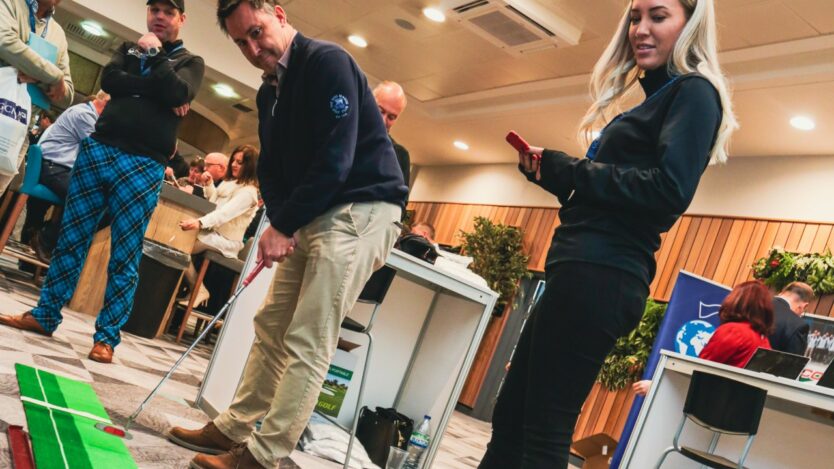GCMA Chief Executive Tom Brooke explains why golf needs to embrace new formats…
This article is part of GCMA Insights – topical content for golf industry professionals, discussing the things that matter to those who work in golf clubs.
Golf needs to change. That’s certainly not the first time it’s been said and I’m pretty sure it won’t be the last!
You can now walk into a clubhouse in jeans. You can have a flexible membership. You can even gain an official handicap without being a member of a club. But if the only game that’s being offered is 18-hole individual Stableford or Medal, which can take over four hours, it’s a barrier to regular participation.
Other sports have realised the need for change. The numbers playing Sunday League football have been dropping but you’ll struggle to find an artificial pitch during the week because they’re full of people playing 5-a-side.
Look at the audiences for The Hundred in cricket. It’s dynamic and enjoyable to watch and It takes less time. There has been a noticeable increase in midweek cricket at grassroots level suiting that model.
Tennis is changing too. Padel Tennis is growing at a phenomenal rate. It is huge in the United States.
Some sports have adapted to suit their target audiences and changing lifestyle habits, but golf has not.
The age profile of a typical club member has started to come down over the last couple of years. While the social restrictions imposed during the pandemic brought about unrecognisable levels of participation, data is now telling us that this has started to slow down again.
If we’re going to retain those people, we’ve got to find ways of keeping them engaged and part of the club experience.
We should be looking at shorter formats that allow a game to played in an hour and a half in a more sociable environment.
There can be an element of competition, but the keys are for it also to be fun, more engaging, and more welcoming.
That will be a challenge for some clubs. In a traditional membership environment, there is going to be real resistance to change.
But over the next three to five years, there’s a great opportunity for clubs to really think about what their core audience is, or what they want it to be; identify their USP in the local marketplace and the direction they want to take their club for the next generation.
What does your target audience want? How can you adapt if you’re looking to grow and build a sustainable model for the next 10 or 20 years?
Club decisions need to be collaborative and strategic and they need to bring people with them on that journey.
For a lot of clubs, there is no need to adapt or change. The traditional golf market will always be there and that’s great. But as the next generation comes through, golfers will be looking for different types of environments and different experiences.
So for some clubs, it will be about adapting at an organic pace. Finding the spaces in the tee sheet that can suit members looking for those different experiences, or perhaps adapting the golf course to provide a shorter loop at off peak times as well as adapting the after-golf clubhouse experience to suit this as well, but without the need for complete change and the risk of alienating your existing membership base.
Get involved in the debate.
To join the GCMA, click here, or to organise a call with a member of the GCMA team, just complete the form below and we’ll be in touch!
We also have a huge opportunity to look at more wholesale change and for those facilities and clubs considering that, it’s about taking the plunge and looking at an entirely new business model, along with investment and a strategic commitment for the long term.
Some clubs are already investing in their facilities to construct new shorter format golf courses, utilising areas of land that have previously been unused or under-utilised. This alone will start to open doors to newer golfers and the family market.
I’m a big fan of business models like TopGolf and Adventure Golf. As an industry we’ve been very excited about the growth in these areas and we’ve expected them to provide the pathway into 18-hole golf at clubs.
The reality is these sorts of things are golf-themed entertainment and family fun. There is a big difference between that and an 18-hole round of golf and there is a huge gap in the level of facility offerings around the country to bridge it.
It’s going to be really interesting to see how the R&A’s new community based golf facility in Glasgow, GolfIt!, takes off when it opens next year. With Adventure Golf, pitch and putt, a driving range and a 9 hole course, hopefully it proves to be a real success and triggers the growth of these sorts of facilities in the near future.
WHY JOIN THE GCMA?
Membership of the GCMA unlocks a network of like-minded professionals, provides you with support in your professional and personal development, and provides you with a multitude of benefits. Whether that’s the tools that will help you to excel in your profession, or a wide range of services to support your wellbeing, signing up to the GCMA is joining a community.
I was also really intrigued with the recent announcement that Tiger Woods and Rory McIlroy are heading up an investment into an entirely new technology-infused, entertainment based format, designed to be team based and taking under two hours to play.
Whilst this exact format and the proposed facility is in an entirely different world in terms of investment levels, I do hope it really sparks the interest and imagination of clubs, facilities and amateur golfers alike to start looking at things a bit differently and trying some new formats.
We’re in a very challenging time. We have had a considerable spike in participation because of the pandemic.
We don’t know, though, what decisions people are going to be making about their leisure habits and spending.
We don’t know how much these external pressures are going to put on people’s ability to spend money on leisure.
In the coming years, I’d like every club to have a chance to identify what their opportunities are and really have the confidence to commit to a long term business plan.
What does that mean for your club or venue? It’s about looking at your target market, your place in the local area, and your USPs, so you can really drive that as a sustainable model.
Are you a traditional club that’s going to stick to 18-hole formats with the more traditional golf club environment? Or are you going to go after a younger demographic, be more family orientated, and focus more on those more social, shorter, formats?
In an ideal world, that’s where we will be in five years’ time – where clubs are adapting accordingly and have put business plans in place to lead that change.
This article is part of GCMA Insights – topical content for golf industry professionals, discussing the things that matter to those who work in golf clubs.
Get involved in the debate. To join the GCMA, click here, or to organise a call with a member of the GCMA team, just complete this form and we’ll be in touch!
Enquiries
"*" indicates required fields



